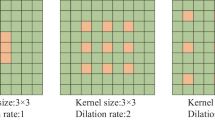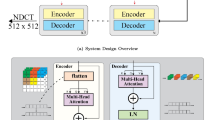Abstract
Low-dose computed tomography (LDCT) imaging can significantly reduce the radiation dose to a patient. However, a low radiation dose will cause considerable noise and artifacts in the image, seriously impacting the clinical diagnosis. To better solve the problems, we propose an edge protection and global attention mechanism densely connected convolutional network (EP–GAMNet) for LDCT denoising. First, edge information was extracted using the improved eight-directional Prewitt operator and then, passed to each convolutional block through skip connections. Subsequently, a multiscale feature extractor and global attention mechanism were used for feature extraction. The final predicted images were then obtained by the noise reduction module. Further, a compound loss function based on mean squared error and perceptual loss was used to enhance the texture detail and improve the visual quality of the image. Extensive experiments on Mayo and piglet datasets showed the effectiveness of the proposed method in reducing noise/artifacts while preserving edges. The peak-signal-to-noise ratio value of CT images of the AAPM dataset processed by the new model is 33.5712, and the structural similarity (SSIM) value is 0.9244. Moreover, it performed better than some classical methods in terms of objective indicators and subjective effects. The proposed model is robust and can effectively retain edge information and extract effective features from LDCT images. Moreover, it is effective in improving LDCT image quality.













Similar content being viewed by others
Data Availability
The data that support the findings of this study are available from the corresponding author upon reasonable request.
References
AAPM. (2016). Low dose CT grand challenge. http://www.aapm.org/GrandChallenge/LowDoseCT/
S. Anwar, Real Image Denois. Feat. Attent. (2019). https://doi.org/10.13140/RG.2.2.13302.45125
M. Balda, J. Hornegger, B. Heismann, Ray contribution masks for structure adaptive sinogram filtering. IEEE Trans. Med. Imaging 31(6), 1228–1239 (2011). https://doi.org/10.1109/TMI.2012.2187213
S. Balochian, H. Baloochian, Edge detection on noisy images using Prewitt operator and fractional order differentiation. Multim. Tools Appl.. 81(7), 9759 (2022)
H. Bovik, Image information and visual quality. IEEE Trans. Image Process. 15(2), 430–444 (2006). https://doi.org/10.1109/TIP.2005.859378
J.F. Cai, X. Jia, H. Gao et al., Cine cone beam CT reconstruction using low-rank matrix factorization: algorithm and a proof-of-principle study. IEEE Trans. Med. Imaging. 33(8), 1581–1591 (2014). https://doi.org/10.1109/TMI.2014.2319055
Y. Chen, X. Dai, H. Duan et al., A quality improvement method for lung LDCT images. J. Xray Sci. Technol. 28(2), 255–270 (2020). https://doi.org/10.3233/XST-190605
Y. Chen, X. Yin, L. Shi et al., Improving abdomen tumor low-dose CT images using a fast dictionary learning based processing. Phys. Med. Biol. 58(16), 5803–5820 (2013)
H. Chen, Y. Zhang et al., Low-dose CT with a residual encoder-decoder convolutional neural network (RED-CNN). IEEE Trans. Med. Imaging 36(12), 2524–2535 (2017). https://doi.org/10.1109/TMI.2017.2715284
H. Chen, Y. Zhang et al., Low-dose CT via convolutional neural network. Biomed. Opt. Express 8(2), 679–694 (2017). https://doi.org/10.1364/BOE.8.000679
Z. Feng, A. Cai, Y. Wang et al., Dual residual convolutional neural network (DRCNN) for low-dose CT imaging. J. Xray Sci. Technol. 29(1), 91–109 (2021). https://doi.org/10.3233/XST-200777
L.W. Goldman, Principles of CT and CT technology. J. Nucl. Med. Technol. 35(3), 115–128 (2007)
Z.T. Guo, Y. Su et al., LDCT denoising method based on dual attention mechanism and compound loss. Laser Optoelect. Progress. 59(02), 154–165 (2022)
M.H. Guo, T.X. Xu, J.J. Liu, Attention mechanisms in computer vision: a survey. Computat. Vis. Media 8(3), 38 (2022). https://doi.org/10.1007/s41095-022-0271-y
Z.F. Han, H. Shangguan, X. Zhang et al., A dual-encoder-single-decoder based low-dose CT denoising network. IEEE J. Biomed. Health Informatics. 26(7), 3251–3260 (2022). https://doi.org/10.1109/JBHI.2022.3155788
D. Hu, Y. Zhang, J. Liu, S. Luo, Y. Chen, DIOR: deep iterative optimization-based residual-learning for limited-angle CT reconstruction. IEEE Trans. Med. Imaging (2022). https://doi.org/10.1109/TMI.2022.3148110
X. Jiang, Y. Jin, Y. Yao, Low-dose CT lung images denoising based on multiscale parallel convolution neural network. SPIE Med. Imaging. 37(4), 2419–2431 (2021). https://doi.org/10.1117/12.2006907
K. He, X. Zhang, S. Ren, and J. Sun, Deep residual learning for image recognition, in 2016 IEEE conference on computer vision and pattern recognition (CVPR) (2016). https://doi.org/10.1109/CVPR.2016.90
J. Kang, Y. Liu, H. Shu et al., Gradient extraction based multiscale dense cross network for LDCT denoising. Nuclear Ins. Methods Phys. Res. A. 1055, 168519 (2023). https://doi.org/10.1016/j.nima.2023.168519
D. Kang, P. Slomka, R. Nakazato et al., Image denoising of low-radiation dose coronary CT angiography by an adaptive block-matching 3D algorithm. SPIE Med. Imaging (2013). https://doi.org/10.1117/12.2006907
Z. Li, L. Yu, J.D. Trzasko et al., Adaptive nonlocal means filtering based on local noise level for CT denoising. Med. Phys. 41(1), 190801–190816 (2014). https://doi.org/10.1117/12.2006907
Y. Liu, Y. Chen, P. Chen et al., Artifact suppressed nonlinear diffusion filtering for low-dose CT image processing. IEEE Access. 7, 9856–9869 (2019). https://doi.org/10.1109/ACCESS.2019.2933541
Y. Liu, J. Ma, Y. Fan et al., Adaptive-weighted total variation minimization for sparse data toward low-dose x-ray computed tomography image reconstruction. Phys. Med. Biol. 57(23), 7923–56 (2012)
M. Diganta, N. Trikay, et al. Rotate to Attend: Convolutional Triplet Attention Module. Comput. Vis. Patt. Recognit. (2021) https://doi.org/10.48550/arXiv.2010.03045
A. Manduca, L. Yu, J.D. Trzasko et al., Projection space denoising with bilateral filtering and CT noise modeling for dose reduction in CT. Med. Phys. 36(11), 4911–4919 (2009). https://doi.org/10.1118/1.3232004
H. Nazki, O. Arandjelovi, I.H. Um et al., MultiPathGan: structure preserving stain normalization using unsupervised multi-domain adversarial network with perception loss. Med. Phys. 36, 4911 (2022). https://doi.org/10.48550/arXiv.2204.09782
Y. Peng, L. Zhang, S. Liu et al., Dilated residual networks with symmetric skip connection for image denoising. Neurocomputing 345, 67–76 (2019). https://doi.org/10.1016/j.neucom.2018.12.075
H. Shangguan, Q. Zhang, Y. Liu et al., Low-dose CT statistical iterative reconstruction via modified MRF regularization. Comput. Methods Programs Biomed. 123, 129–141 (2016)
R. Smith-Bindman, J. Lipson, R. Marcus et al., Radiation dose associated with common computed tomography examinations and the associated lifetime attributable risk of cancer. Arch. Int. Med. 169(22), 2078–2086 (2009)
T. Liang, Y. Jin, Y. Li, et al. EDCNN: edge enhancement-based densely connected network with compound loss for low-dose CT denoising. 2020 15th IEEE international conference on signal processing (ICSP), Beijing, China, (2020). https://doi.org/10.1109/ICSP48669.2020.9320928
C. Tian, Y. Xu, Z. Li et al., Attention-guided CNN for image denoising. Neural Netw. 124, 117–129 (2020)
R. Vanithamani, G. Umamaheswari, Speckle reduction in ultrasound images using neighshrink and bilateral filtering. J. Comput. Sci. 10(4), 623–631 (2014)
W. Sanghyun, P. Jongchan, et al. CBAM: convolutional block attention module, in proceedings of the IEEE conference on computer vision and pattern recognition (CVPR) (2018). doi https://doi.org/10.48550/arXiv.1807.06521
D. Wang, F. Fan, Z. Wu et al., CTformer: convolution-free token2token dilated vision transformer for low-dose CT denoising. Comput. Sci. 10, 623 (2022). https://doi.org/10.48550/arXiv.2202.13517
D. Wang, Z. Wu, H. Yu, TED-net: convolution-free T2T vision transformer-based encoder-decoder dilation network for low-dose CT denoising. Mach. Learn. Med. Imaging (2021). https://doi.org/10.1007/978-3-030-87589-3_43
W. Xue, L. Zhang, X. Mou et al., Gradient magnitude similarity deviation: a highly efficient perceptual image quality index. IEEE Trans. Image Process. 23(2), 684–695 (2014). https://doi.org/10.1109/TIP.2013.2293423
Y. Liu, Z. Shao, N. Hoffmann, Global attention mechanism: retain information to enhance channel-spatial interactions. (2021). https://doi.org/10.48550/arXiv.2112.05561
W. Yao, J.B. Farr, A multiscale filter for noise reduction of low-dose cone beam projections. Phys. Med. Biol. 60(16), 6515–6530 (2015). https://doi.org/10.1088/0031-9155/60/16/6515
X. Yi, B. Paul, Sharpness-aware low-dose CT denoising using conditional generative adversarial network. J. Digit. Imaging 31(5), 655–669 (2018). https://doi.org/10.1007/s10278-018-0056-0
J. Zhang, H.L. Zhou, Y. Niu et al., CNN and multi-feature extraction based denoising of CT images. Biomed. Signal Process. Control 67, 102545 (2021). https://doi.org/10.1016/j.bspc.2021.102545
S. Zhu, J. Wang, Y. Cai, Low-dose CT denoising algorithm based on improved cycle GAN. Acta Opt. Sin. 40(22), 70–78 (2020). https://doi.org/10.3788/AOS202040.2210002
Funding
This work was supported by the Open Fund Project of the Key Laboratory of Computer Network and Information Integration of the Ministry of Education (K93-9-2022-02), the Science and Technology Innovation Project of Colleges and Universities of Shanxi Province (2020L0282), the Key R&D plan of Shanxi Province (202102020101009), and the Natural Science Foundation of Shanxi Province (202103021224204).
Author information
Authors and Affiliations
Corresponding author
Ethics declarations
Conflict of interest
We declare that we do not have any commercial or associative interest that represents a conflict of interest in connection with the work submitted.
Additional information
Publisher's Note
Springer Nature remains neutral with regard to jurisdictional claims in published maps and institutional affiliations.
Rights and permissions
Springer Nature or its licensor (e.g. a society or other partner) holds exclusive rights to this article under a publishing agreement with the author(s) or other rightsholder(s); author self-archiving of the accepted manuscript version of this article is solely governed by the terms of such publishing agreement and applicable law.
About this article
Cite this article
Kang, J., Liu, Y., Shu, H. et al. Edge Protection and Global Attention Mechanism Densely Connected Convolutional Network for LDCT Denoising. Circuits Syst Signal Process 43, 941–964 (2024). https://doi.org/10.1007/s00034-023-02488-y
Received:
Revised:
Accepted:
Published:
Issue Date:
DOI: https://doi.org/10.1007/s00034-023-02488-y




